2000 FORD F150 jump start
[x] Cancel search: jump startPage 175 of 280
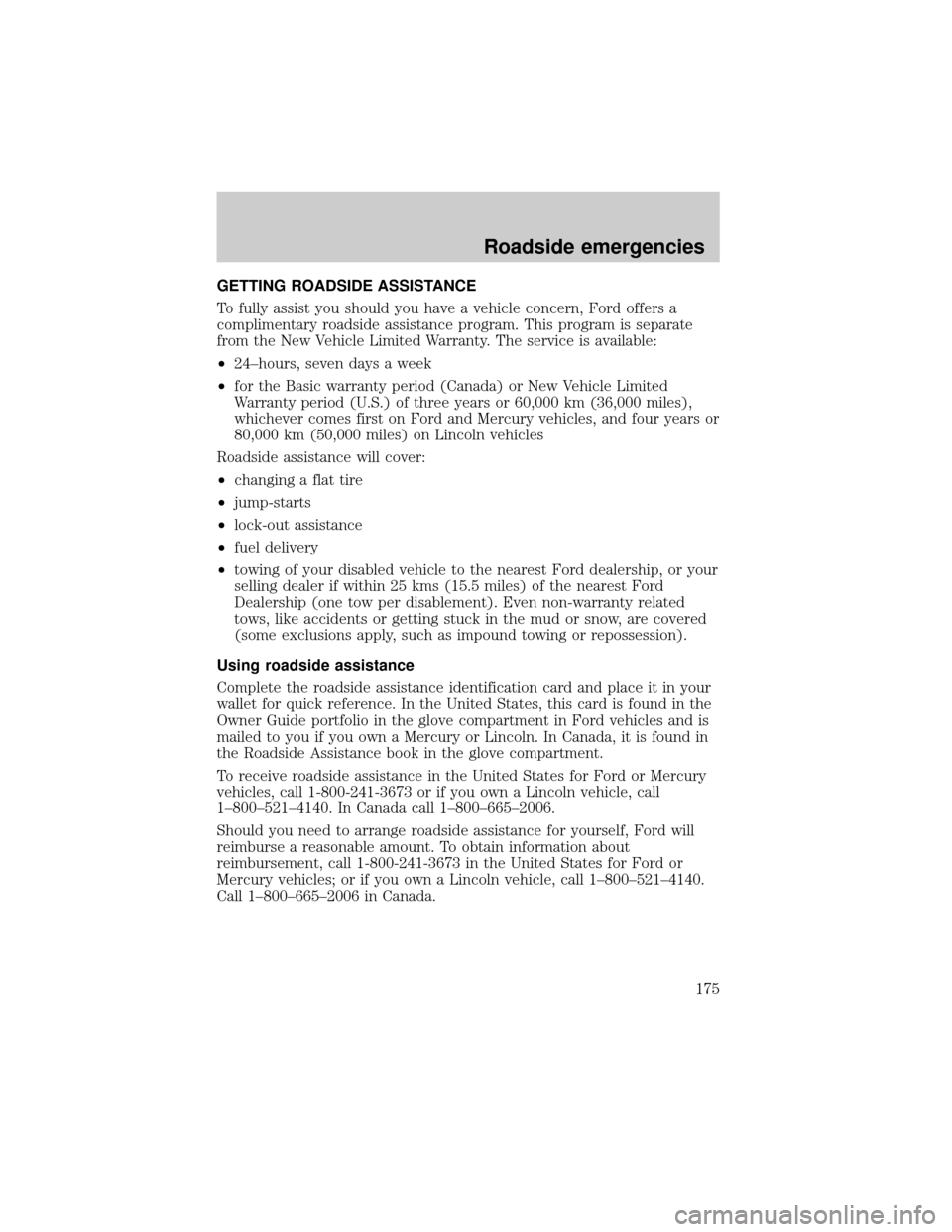
GETTING ROADSIDE ASSISTANCE
To fully assist you should you have a vehicle concern, Ford offers a
complimentary roadside assistance program. This program is separate
from the New Vehicle Limited Warranty. The service is available:
²24±hours, seven days a week
²for the Basic warranty period (Canada) or New Vehicle Limited
Warranty period (U.S.) of three years or 60,000 km (36,000 miles),
whichever comes first on Ford and Mercury vehicles, and four years or
80,000 km (50,000 miles) on Lincoln vehicles
Roadside assistance will cover:
²changing a flat tire
²jump-starts
²lock-out assistance
²fuel delivery
²towing of your disabled vehicle to the nearest Ford dealership, or your
selling dealer if within 25 kms (15.5 miles) of the nearest Ford
Dealership (one tow per disablement). Even non-warranty related
tows, like accidents or getting stuck in the mud or snow, are covered
(some exclusions apply, such as impound towing or repossession).
Using roadside assistance
Complete the roadside assistance identification card and place it in your
wallet for quick reference. In the United States, this card is found in the
Owner Guide portfolio in the glove compartment in Ford vehicles and is
mailed to you if you own a Mercury or Lincoln. In Canada, it is found in
the Roadside Assistance book in the glove compartment.
To receive roadside assistance in the United States for Ford or Mercury
vehicles, call 1-800-241-3673 or if you own a Lincoln vehicle, call
1±800±521±4140. In Canada call 1±800±665±2006.
Should you need to arrange roadside assistance for yourself, Ford will
reimburse a reasonable amount. To obtain information about
reimbursement, call 1-800-241-3673 in the United States for Ford or
Mercury vehicles; or if you own a Lincoln vehicle, call 1±800±521±4140.
Call 1±800±665±2006 in Canada.
Roadside emergencies
175
Page 190 of 280
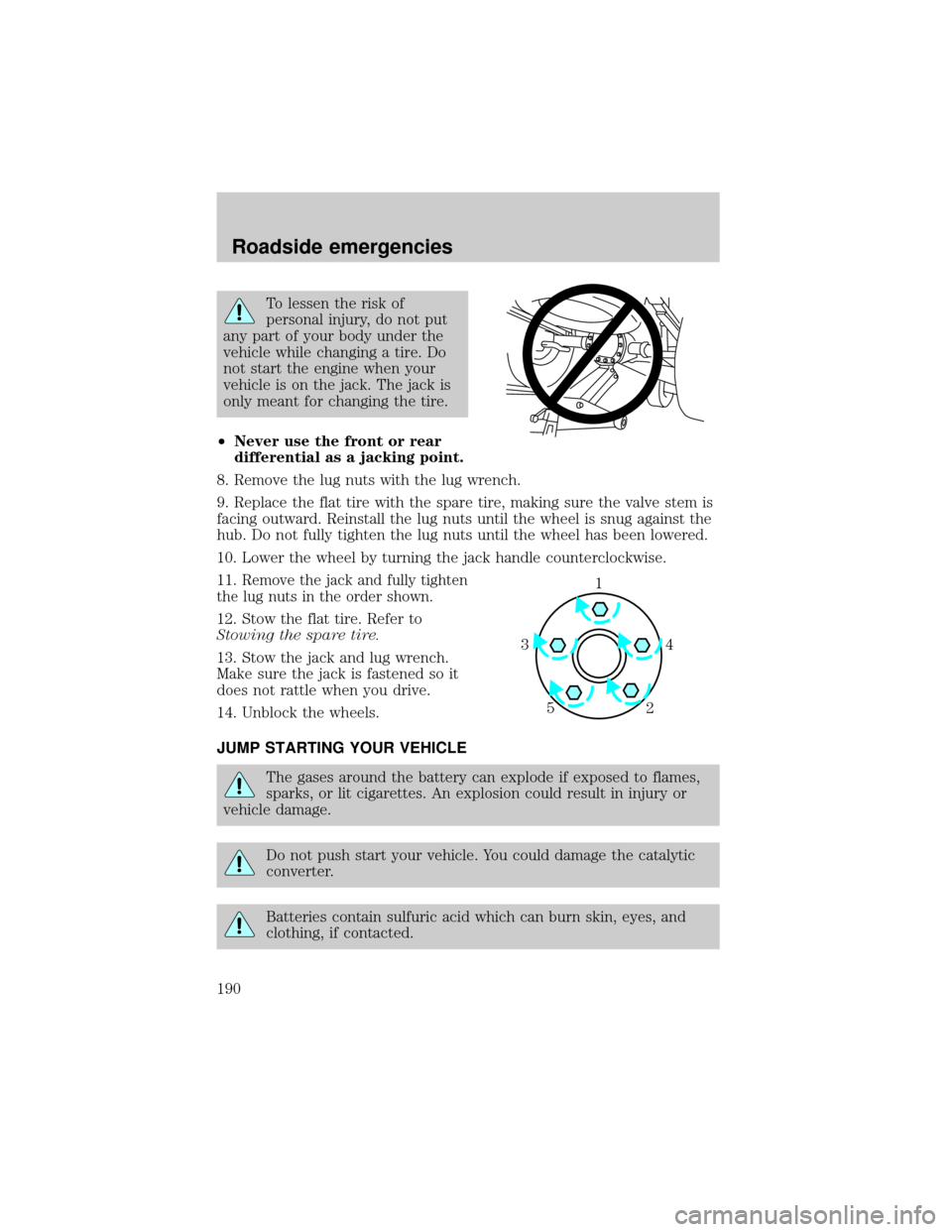
To lessen the risk of
personal injury, do not put
any part of your body under the
vehicle while changing a tire. Do
not start the engine when your
vehicle is on the jack. The jack is
only meant for changing the tire.
²Never use the front or rear
differential as a jacking point.
8. Remove the lug nuts with the lug wrench.
9. Replace the flat tire with the spare tire, making sure the valve stem is
facing outward. Reinstall the lug nuts until the wheel is snug against the
hub. Do not fully tighten the lug nuts until the wheel has been lowered.
10. Lower the wheel by turning the jack handle counterclockwise.
11.
Remove the jack and fully tighten
the lug nuts in the order shown.
12. Stow the flat tire. Refer to
Stowing the spare tire.
13. Stow the jack and lug wrench.
Make sure the jack is fastened so it
does not rattle when you drive.
14. Unblock the wheels.
JUMP STARTING YOUR VEHICLE
The gases around the battery can explode if exposed to flames,
sparks, or lit cigarettes. An explosion could result in injury or
vehicle damage.
Do not push start your vehicle. You could damage the catalytic
converter.
Batteries contain sulfuric acid which can burn skin, eyes, and
clothing, if contacted.
1
4 3
2 5
Roadside emergencies
190
Page 191 of 280
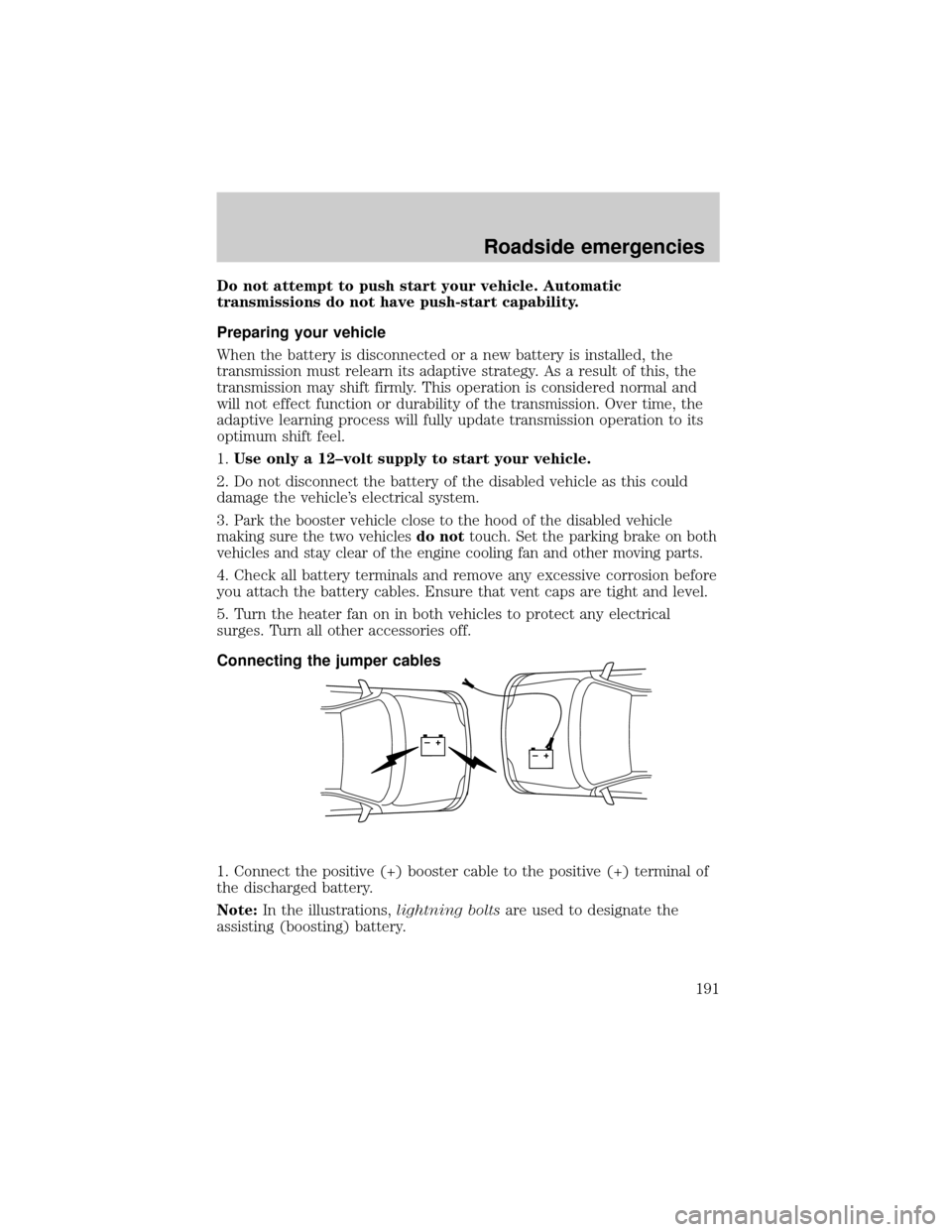
Do not attempt to push start your vehicle. Automatic
transmissions do not have push-start capability.
Preparing your vehicle
When the battery is disconnected or a new battery is installed, the
transmission must relearn its adaptive strategy. As a result of this, the
transmission may shift firmly. This operation is considered normal and
will not effect function or durability of the transmission. Over time, the
adaptive learning process will fully update transmission operation to its
optimum shift feel.
1.Use only a 12±volt supply to start your vehicle.
2. Do not disconnect the battery of the disabled vehicle as this could
damage the vehicle's electrical system.
3.
Park the booster vehicle close to the hood of the disabled vehicle
making sure the two vehiclesdo nottouch. Set the parking brake on both
vehicles and stay clear of the engine cooling fan and other moving parts.
4. Check all battery terminals and remove any excessive corrosion before
you attach the battery cables. Ensure that vent caps are tight and level.
5. Turn the heater fan on in both vehicles to protect any electrical
surges. Turn all other accessories off.
Connecting the jumper cables
1. Connect the positive (+) booster cable to the positive (+) terminal of
the discharged battery.
Note:In the illustrations,lightning boltsare used to designate the
assisting (boosting) battery.
+–+–
Roadside emergencies
191
Page 193 of 280
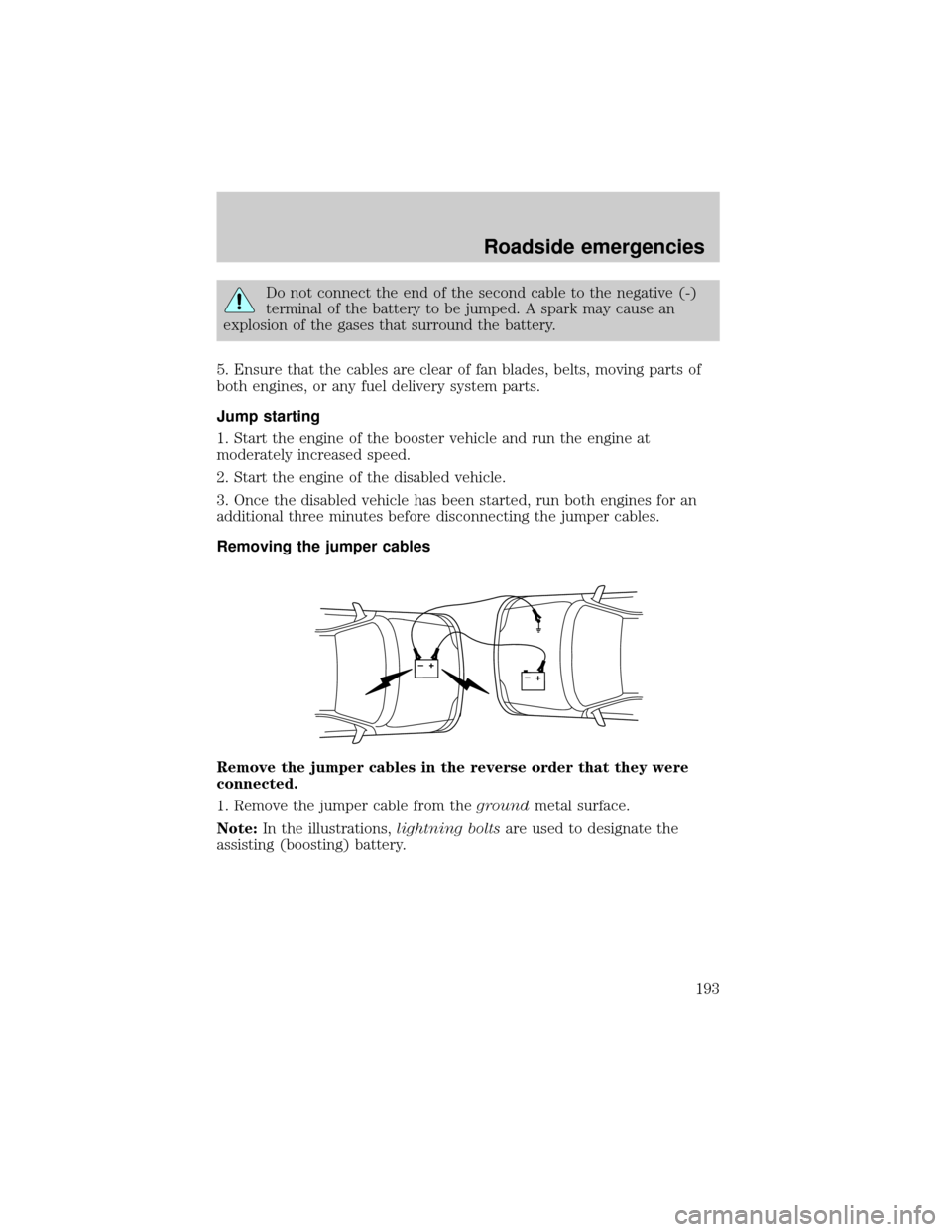
Do not connect the end of the second cable to the negative (-)
terminal of the battery to be jumped. A spark may cause an
explosion of the gases that surround the battery.
5. Ensure that the cables are clear of fan blades, belts, moving parts of
both engines, or any fuel delivery system parts.
Jump starting
1. Start the engine of the booster vehicle and run the engine at
moderately increased speed.
2. Start the engine of the disabled vehicle.
3. Once the disabled vehicle has been started, run both engines for an
additional three minutes before disconnecting the jumper cables.
Removing the jumper cables
Remove the jumper cables in the reverse order that they were
connected.
1. Remove the jumper cable from thegroundmetal surface.
Note:In the illustrations,lightning boltsare used to designate the
assisting (boosting) battery.
+–+–
Roadside emergencies
193
Page 195 of 280
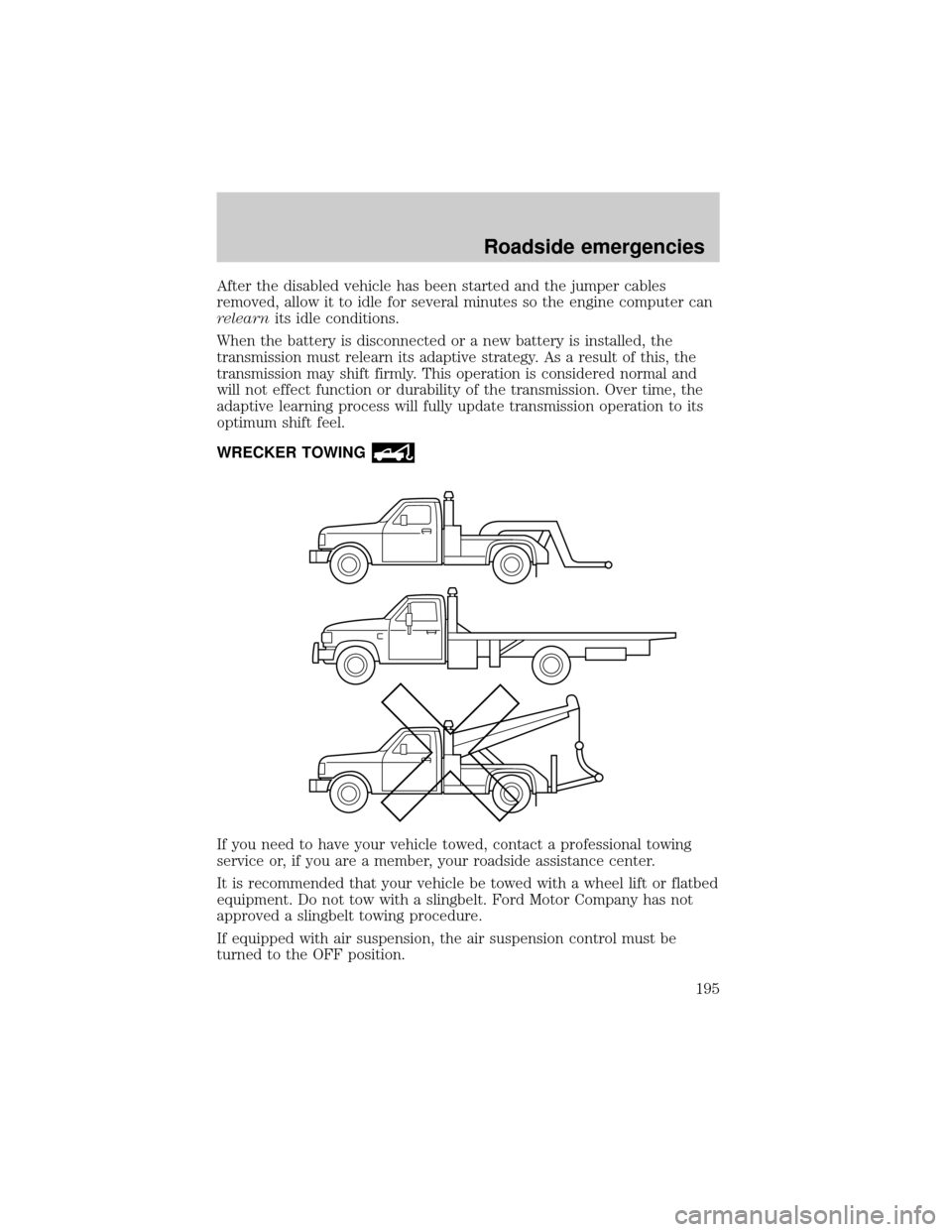
After the disabled vehicle has been started and the jumper cables
removed, allow it to idle for several minutes so the engine computer can
relearnits idle conditions.
When the battery is disconnected or a new battery is installed, the
transmission must relearn its adaptive strategy. As a result of this, the
transmission may shift firmly. This operation is considered normal and
will not effect function or durability of the transmission. Over time, the
adaptive learning process will fully update transmission operation to its
optimum shift feel.
WRECKER TOWING
If you need to have your vehicle towed, contact a professional towing
service or, if you are a member, your roadside assistance center.
It is recommended that your vehicle be towed with a wheel lift or flatbed
equipment. Do not tow with a slingbelt. Ford Motor Company has not
approved a slingbelt towing procedure.
If equipped with air suspension, the air suspension control must be
turned to the OFF position.
Roadside emergencies
195
Page 274 of 280

Cleaning your vehicle ...............242
engine compartment ..............243
exterior ............................243, 246
exterior lamps .........................244
instrument cluster lens ..........245
instrument panel ....................245
interior .....................................245
plastic parts ............................244
safety belts ..............................245
washing ....................................242
waxing .....................................242
wheels ......................................243
wiper blades ............................244
Climate control (see Air
conditioning or Heating) ............60
Clock ..........................28, 34, 45, 54
Clutch
fluid ..........................................204
operation while driving ..........147
recommended shift speeds ....149
Compass, electronic ....................75
calibration .................................77
set zone adjustment .................76
Console
overhead ....................................73
Controls
power seat .................................99
Coolant
checking and adding ..............206
refill capacities ................210, 248
specifications ..................251, 253
Cruise control
(see Speed control) ....................67
Customer Assistance ................175
Ford accessories for your
vehicle .....................................266
Ford Extended
Service Plan ............................259Getting assistance outside
the U.S. and Canada ..............265
Getting roadside assistance ...175
Getting the
service you need ....................259
Ordering additional
owner's literature ...................270
The Dispute
Settlement Board ...................262
Utilizing the Mediation/
Arbitration Program ...............265
D
Daytime running lamps
(see Lamps) ................................20
Dipstick
automatic
transmission fluid ...................213
engine oil .................................200
Doors
door ajar warning .....................15
lubricant specifications ..........251
Driveline universal joint
and slip yoke .............................218
Driving under special
conditions ..........................158±159
mud ..........................................158
sand .........................................158
snow and ice ...........................159
through water .................158, 162
E
Emergencies, roadside
jump-starting ..........................190
Emission control system ..........235
Engine ........................................253
Index
274
Page 276 of 280

driving with a heavy load ......160
location ....................................160
GVWR (Gross
Vehicle Weight Rating) .............160
calculating .......................160, 162
definition .................................160
driving with a heavy load ......160
location ....................................160
H
Hazard flashers .........................176
Headlamps ...................................20
aiming ......................................242
autolamp system .......................22
bulb specifications ..................241
daytime running lights .............20
flash to pass ..............................20
high beam ...........................13, 20
replacing bulbs .......................237
turning on and off ....................20
warning chime ..........................15
Heating ........................................60
heater only system ...................60
heating and
air conditioning system ............62
Hood ..........................................198
I
Ignition .................................66, 253
removing the key ....................153
Infant seats
(see Safety seats) .....................123
Inspection/maintenance
(I/M) testing ..............................236
Instrument panel
cleaning ...................................245
cluster ................................10, 245lighting up
panel and interior .....................21
location of components ............10
J
Jack ............................................185
positioning ...............................185
storage .....................................185
Jump-starting your vehicle ......190
K
Keyless entry system
autolock .....................................91
locking and unlocking doors ....95
programming entry code .........95
Keys
key in ignition chime ...............15
positions of the ignition ...........66
removing from the ignition ....153
L
Lamps
autolamp system .......................22
bulb replacement
specifications chart ................241
cargo lamps ...............................21
daytime running light ...............20
fog lamps ...................................21
headlamps .................................20
headlamps, flash to pass ..........20
instrument panel, dimming .....21
interior lamps ...........................77
replacing bulbs ...............236±241
Lane change indicator
(see Turn signal) ........................66
Lights, warning and indicator ....10
air bag ........................................12
Index
276
Page 278 of 280

S
Safety belts (see Safety
restraints) ....................15, 102±106
Safety defects, reporting ..........272
Safety restraints ................102±106
belt minder .............................108
cleaning the
safety belts ......................112, 245
extension assembly ................107
for adults .........................103±105
for children .............................122
lap belt ....................................107
warning light
and chime ....................12, 15, 108
Safety seats for children ..........123
Seat belts
(see Safety restraints) .............102
Seats ............................................97
child safety seats ....................123
cleaning ...................................246
SecuriLock passive
anti-theft system ...................87±88
Servicing your vehicle ..............197
Snowplowing .................3, 171±173
Spark plugs,
specifications .....................247, 253
Special notice ............................3, 5
ambulance conversions ..............3
four-wheel drive vehicles .......174
utility-type vehicles ....................4
Specification chart,
lubricants ...........................251, 253
Speed control ..............................67
Speedometer ...............................17
Starting your vehicle ........133, 136jump starting ..........................190
Steering wheel
tilting .........................................71
T
Tachometer .................................18
Tailgate ..................................81±82
Tires ...........................185, 222±224
changing ..........................185, 187
checking the pressure ............224
replacing ..................................225
rotating ....................................224
snow tires and chains ............226
tire grades ...............................223
treadwear ................................223
Tonneau cover .......................82, 86
Towing .......................................224
recreational towing .................170
wrecker ....................................195
Traction-lok rear axle ...............142
Transfer case
fluid checking .........................217
Transmission
automatic operation ...............144
fluid, checking and adding
(automatic) .............................213
fluid, checking and adding
(manual) .................................216
fluid, refill capacities ..............248
lubricant specifications ..251, 253
manual operation ....................147
Transmission
control indicator light .................14
Trip odometer .............................18
Trunk ...........................................86
Turn signal ............................13, 66
Index
278